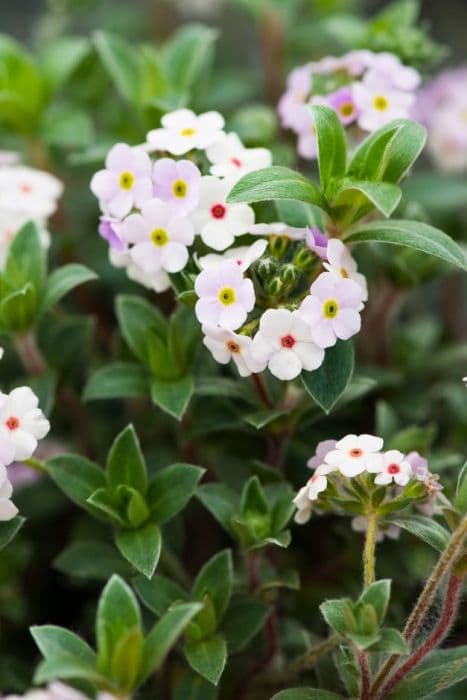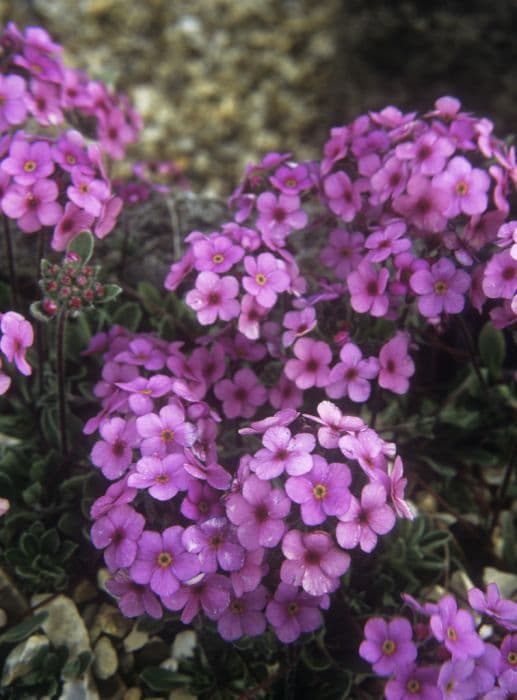Auricula Primula auricula 'Rajah' (Au/s)

ABOUT
Primula auricula 'Rajah', more commonly known as Auricula or Bear's Ear, is a charming perennial plant with a distinctive appearance. Its foliage comprises compact rosettes of succulent, almost leathery leaves, which are typically a deep green hue, providing a rich backdrop for the flowers. The blooms of 'Rajah' are particularly noteworthy, featuring a unique palette of colors. The flowers form dense clusters at the top of the stems, each one showcasing a vivid, deep red or burgundy shade with a velvety texture. At the center of each flower, there's often a contrasting, bright yellow or golden eye, which adds to the plant's striking aesthetics. This variety typically blooms in spring, providing a brilliant display of color that can liven up garden borders, rock gardens, or alpine displays. Its ornate blossoms are also a favorite for floral displays, with the contrast of the deep-colored petals and the vibrant center drawing the eye. In addition to its eye-catching flowers, the Auricula 'Rajah' is appreciated for its overall neat and tidy habit, which makes it an attractive plant even when not in bloom. The plant's foliage remains a point of visual interest throughout the growing season, contributing to the texture and depth of garden arrangements.
About this plant
 Names
NamesSynonyms
Bear's Ear, Mountain Cowslip, Auricula, Auricula Primrose
Common names
Primula auricula 'Rajah' (Au/s).
 Toxicity
ToxicityTo humans
Auricula is not listed as a toxic plant to humans. However, some individuals may be sensitive to the plant and can experience mild irritation if they have skin contact with its sap or if they ingest part of the plant. It is always advisable to handle plants with care and avoid ingestion if you are unsure of their edibility or potential for toxicity.
To pets
Auricula is not typically listed as toxic to pets either. However, as with humans, some animals might be sensitive to the plant. Ingesting parts of the Auricula could potentially cause mild gastrointestinal upset in some pets. It's always best to keep houseplants out of reach of pets and to consult with a veterinarian if you suspect your pet has ingested any part of a plant.
 Characteristics
CharacteristicsLife cycle
Perennials
Foliage type
Evergreen
Color of leaves
Green
Flower color
Yellow
Height
6 inches (15 cm)
Spread
6 inches (15 cm)
Plant type
Herb
Hardiness zones
5
Native area
Europe
Benefits
 General Benefits
General Benefits- Aesthetic Appeal: Adds vibrant color and visual interest to gardens with its striking red-orange flowers.
- Easy to Grow: Known for being hardy and relatively low-maintenance, making it suitable for novice gardeners.
- Compact Size: Ideal for small spaces or rock gardens due to its compact growth habit.
- Attracts Pollinators: Flowers can attract bees and butterflies, which are beneficial for pollination in the garden.
- Seasonal Interest: Offers early spring blooms that can enliven a garden after the winter season.
- Versatile Planting: Suitable for border fronts, containers, and alpine gardens, providing flexibility in garden design.
- Deer Resistant: Less likely to be eaten by deer, which can be an advantage in areas with deer pressure.
 Medical Properties
Medical PropertiesThis plant is not used for medical purposes.
 Air-purifying Qualities
Air-purifying QualitiesThis plant is not specifically known for air purifying qualities.
 Other Uses
Other Uses- Auricula Theatres: Historically, Auriculas like Primula auricula 'Rajah' have been displayed in specialized wooden shelving units known as Auricula Theatres, which were a fashionable way to showcase these flowers in the 17th and 18th centuries.
- Photography Subjects: Because of their vivid colors and unique patterns, Primula auriculas make excellent subjects for botanical photography, allowing photographers to showcase their intricate details.
- Educational Tool: Primula auriculas can be used in educational settings, such as schools or botanical gardens, to teach about plant genetics and hybridization due to their diverse range of colors and forms.
- Craft Inspiration: The distinctive appearance of Primula auriculas can be used as inspiration for arts and crafts, including fabric designs, paper crafts, and even jewelry making.
- Color Dye: Historically, certain plants from the Primula family have been used to create natural dyes, and while less common, Primula auriculas could potentially be used to derive color for textile dyeing.
- Culinary Decoration: The non-toxic petals of Primula auriculas may be used as decorative additions to salads and desserts, although the flavors are typically bland or slightly bitter.
- Floral Arrangements: Primula auricula flowers can be incorporated into small floral arrangements, such as table centerpieces or wedding bouquets, for a unique touch of color and texture.
- Scented Gardens: While Primula auriculas are not as known for their fragrance as other flowers, they can contribute a subtle scent to scented gardens or sensory pathways.
- Container Gardening: Due to their compact size, Primula auriculas are suitable for container gardening, providing an attractive display on patios, balconies, or window sills.
- Cultural Symbolism: In certain cultures, Primula auriculas may carry symbolic meanings, such as in the language of flowers where different flower varieties can represent different messages or sentiments.
Interesting Facts
 Feng Shui
Feng ShuiThe Primrose is not used in Feng Shui practice.
 Zodiac Sign Compitability
Zodiac Sign CompitabilityThe Primrose is not used in astrology practice.
 Plant Symbolism
Plant Symbolism- Paternity: The Primula auricula, commonly known as "Auricula," is often associated with a symbol of fatherhood or the paternal aspect due to its traditional usage in floriography to represent men or fathers.
- Unique Beauty: Auriculas are known for their unique and varied patterns. This plant symbolizes the beauty of being unique and the appreciation of individual differences.
- Persistence: The Auricula, with its capacity to bloom in early spring, signifies persistence and the ability to thrive in challenging conditions, as it pushes through the last remnants of winter to bloom.
- Adaptation: As an alpine plant, the Auricula has adapted to thrive in high altitude conditions, which makes it a symbol of adaptability and resilience in the face of difficult environments.
 Water
WaterFor the Bear's ear, water the plant thoroughly, allowing the top inch of soil to dry out between waterings. Depending on temperature and humidity, this may mean watering once every 7 to 10 days. Use room temperature water and gently pour it until it begins to run out of the bottom of the pot; this might equate to approximately 16-24 onzes for a medium-sized pot. Be cautious of overwatering, as Bear's ear is sensitive to root rot.
 Light
LightBear's ear prefers bright, indirect light. A north or east-facing window is ideal as it provides the gentle morning sunlight while protecting the plant from the harsher afternoon sun. Avoid placing it in direct sunlight during the summertime which can scorch the foliage.
 Temperature
TemperatureBear's ear thrives in cool temperatures, ideally between 50°F and 65°F, and can tolerate a range down to 32°F and up to 80°F. However, sustained temperatures outside 50°F-65°F can stress the plant, so it is best to avoid extreme heat or cold.
 Pruning
PruningPrune Bear's ear to remove dead or yellowing leaves to maintain its appearance and encourage healthy growth. The best time to prune is in the spring or after flowering. Trimming off spent flower stalks can also promote a second bloom. Do this gently, using clean, sharp scissors or pruning shears.
 Cleaning
CleaningAs needed
 Soil
SoilAuricula prefers a well-draining, slightly alkaline to neutral soil mix with a pH between 6.0 and 7.5. A good mix would be one part loam, one part grit or perlite, and one part leaf mold or peat-free compost. Provide good drainage to prevent root rot.
 Repotting
RepottingAuriculas should be repotted annually in the spring. This helps to refresh the soil and allows for checking and treating any potential root issues, thus ensuring the continued health of the plant.
 Humidity & Misting
Humidity & MistingAuriculas prefer moderate humidity levels, around 50-60%. They do not tolerate high humidity well, which can lead to fungal issues.
 Suitable locations
Suitable locationsIndoor
Ensure bright indirect light, cool temps, and regular watering.
Outdoor
Plant in partial shade, sheltered from extreme weather.
Hardiness zone
4-8 USDA
 Life cycle
Life cycleThe Auricula, specifically 'Rajah' (Au/s), begins its life cycle as a seed, which germinates in moist, well-drained soil in a cool, partially shaded environment. Following germination, the seedling emerges and develops a rosette of basal leaves, subsequently entering a vegetative growth phase. The plant then matures and enters a reproductive phase, typically in the spring, when it produces stalks with clusters of ornate, colorful flowers. After pollination, often by insects, it sets seed which, once matured, can be disbursed to create new plants. The Auricula is a perennial, and after flowering, it often undergoes a dormancy period, particularly in regions with colder winters, before resuming growth again in the following season. During its lifetime, the plant can be divided and propagated to produce new plants, thus continuing its life cycle.
 Propogation
PropogationPropogation time
Spring-Early Summer
Primula auricula 'Rajah', commonly known as Auricula Primrose, is best propagated through division, which should be done in late summer after the blooming period. To propagate by division, carefully lift the parent plant from the ground and brush off any excess soil to reveal the root system. Gently separate the offsets or clumps that have formed at the base of the plant, ensuring that each division has a segment of roots attached. Replant these divisions at the same depth they were growing originally, spacing them about 6 to 8 inches (15 to 20 centimeters) apart to give them ample room to grow. Water the newly planted divisions well to help establish them. This method facilitates the quick production of new plants that are true to the parent's characteristics and helps to rejuvenate older clumps that may have become woody or less vigorous over time.









